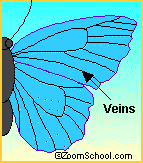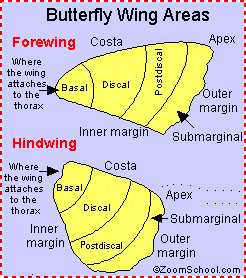 Butterfly Wing Anatomy Butterfly Wing Anatomy   A butterfly has four wings, two forewings and two hindwings. They are attached to the second and third thoracic segments (the meso- and meta-thorax). Strong muscles in the thorax move the wings up and down in a figure-eight pattern during flight. A butterfly has four wings, two forewings and two hindwings. They are attached to the second and third thoracic segments (the meso- and meta-thorax). Strong muscles in the thorax move the wings up and down in a figure-eight pattern during flight. When the fully-grown adult butterfly emerges from its pupa, its delicate wings are crinkled, wet, and uninflated. The butterfly hangs upside-down and pumps blood into the wings to inflate them. It must then wait for the wings to dry before it can fly. When the fragile wings fray or are torn, they do not repair themselves.
 Wing Structure and Scales: Butterfly wings are made of two chitonous layers (membranes) that are nourished and supported by tubular veins. The veins also function in oxygen exchange ("breathing"). Covering the wings are thousands of colorful scales, together with many hairs (setae). The name Lepidoptera (which includes butterflies and moths) means "scale wing" in Greek. These wing scales are tiny overlapping pieces of chitin on a butterfly or moth wing. The scales are outgrowths of the body wall and are modified, plate-like setae (hairs). The front and back of the wings usually have different patterns. Wing Structure and Scales: Butterfly wings are made of two chitonous layers (membranes) that are nourished and supported by tubular veins. The veins also function in oxygen exchange ("breathing"). Covering the wings are thousands of colorful scales, together with many hairs (setae). The name Lepidoptera (which includes butterflies and moths) means "scale wing" in Greek. These wing scales are tiny overlapping pieces of chitin on a butterfly or moth wing. The scales are outgrowths of the body wall and are modified, plate-like setae (hairs). The front and back of the wings usually have different patterns. Scent scales are modified wing scales on the forewing of male butterflies and moths (on the costal fold) that release pheromones. These chemicals attract females of the same species. Scent scales are also called androconia. 
WINGSPAN
Wingspan is the distance measured across a butterfly's (or moth's) wings. The butterfly with the biggest wingspan is the Queen Alexandra's Birdwing, which has a wingspan up to 1 ft (30 cm) wide. | Color: Many butterflies and moths are brilliantly colored, while others are drab. There are often ultraviolet patterns in the wings that we cannot see, but which may be seen by other butterflies. Even many of the colorful species have drab-colored outer wings (that are visible when the animal is at rest). The coloration of these insects serves many purposes, including: - Camouflage, in which the color of the animal helps it blend into the environment, hiding the insect. The Australian leafwing butterfly, for example, is shaped and colored like a leaf.
- Warning (or aposematic) coloration: brightly-colored butterflies and moths are either bad-tasting or a mimic of similar-looking bad-tasting butterflies.
- Attracting and finding mates, who look for certain colors and patterns.
- Deceiving predators into thinking they're bigger than they really are. Some wings have large "eyespots" which make the butterfly or moth look like the face of a larger animal (like an owl), scaring away some predators.
- Soaking up heat: dark-colored scales soak up heat very well when the butterfly suns itself. Like all insects, butterflies are cold-blooded. When they get too cold, they warm themselves in the sun.
 Butterfly Wing Areas: A butterfly's wings are divided into the areas named in the illustration to the left. Butterfly Wing Areas: A butterfly's wings are divided into the areas named in the illustration to the left. The Coupling of the Wings: During flight, the forewing and hindwing are held together and function as one wing. The coupling mechanism differs in different species. In most butterflies, a lobe on the hindwing presses against the forewing. In most moths, bristles on the front edge of the hind wings (called the frenulum) connect with hooks on the hind edge of the forewing. In some moths, a lobe at the base of the forewings (called the jugum) overlaps the hindwings.  Wings At Rest: When at rest, butterflies hold their wings vertically. Moths hold their wings horizontally when at rest. A monarch butterfly at rest is pictured to the right. Wings At Rest: When at rest, butterflies hold their wings vertically. Moths hold their wings horizontally when at rest. A monarch butterfly at rest is pictured to the right.
|
 Free Forum Hosting
Free Forum Hosting